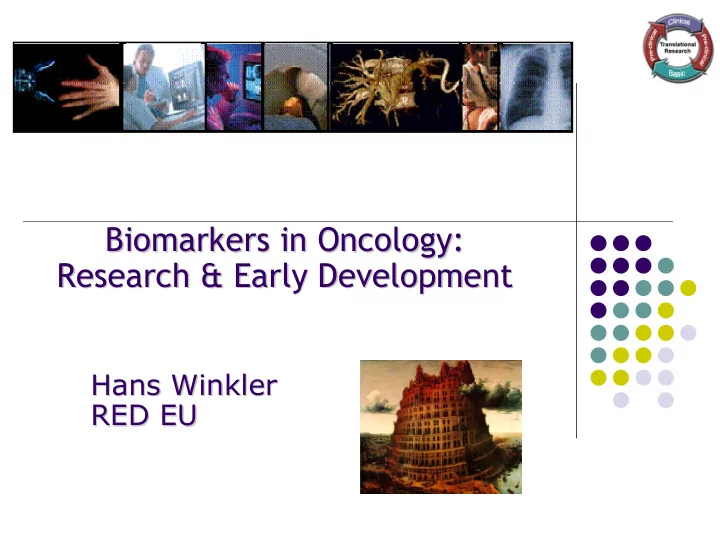

Biomarkers in Oncology: Biomarkers in Oncology: Research & Early Development Research & Early Development Hans Winkler Hans Winkler RED EU RED EU
The Reality of Targeted Therapy The Reality of Targeted Therapy In any particular indication response rates can be � In any particular indication response rates can be � below 20% below 20% This can lead to many patients being treated without � This can lead to many patients being treated without � benefit benefit � Subsets due to molecular heterogeneity of tumors Subsets due to molecular heterogeneity of tumors � Moreover, this results in the requirement for large � Moreover, this results in the requirement for large � numbers of patients to demonstrate clinical benefit numbers of patients to demonstrate clinical benefit and non- -inferiority inferiority and non � Higher risk and cost, higher chance of failure Higher risk and cost, higher chance of failure � 083106 2
Cancer Biomarkers in Clinical Use 083106 3
Concept & Approach � A set of analytes (response signature) as the measure of sensitivity of a tumor to a given treatment � Proposed Approach 1. Identify analytes which differentiate a responding tumor cell line or ex vivo tumor culture from a non- responding tumor cell line or ex vivo tumor culture based on IC 50 2. Confirm and refine the signature by data generated from primary tumors as well as external data 3. Assess the validity of the signature in Phase 2 trials and adjust it further as necessary 083106 4
Current Strategies Prognostic signature identification � Identification array signature that predicts sensitivity to our candidate drugs in tumour cell lines in vitro before treatment � Tumor cell lines � growth curves, IC50s; identified responder and non responder cell lines � array profiles in triplicate arrays � Genomic DNA (epigenomics, sequencing) � Kinase activity profiling (Pamgene) � Classifier tool development and evaluation � Signatures were identified using PAM, 083106 5 Genetic Algorithm (GA), Random forest and Gibbs sampling
Training, Validation & Prediction Training, Validation & Prediction 083106 6 Training and validation: Responders (n=7) Training and validation: Non-Responders (n=7) Prediction (n=12)
Gene Selection Gene Selection optimal gene number for Prediction Analysis of Microarrays optimal gene number for Prediction Analysis of Microarrays - - PAM PAM 0.55 0.55 0.50 0.50 0.45 0.45 Misclassification error Misclassification error 0.40 0.40 0.35 0.35 0.30 0.30 0.25 0.25 0.20 0.20 083106 7 23400 9320 3420 1124 410 119 65 29 16 11 5 3 23400 9320 3420 1124 410 119 65 29 16 11 5 3 number of genes number of genes
Nested- -loop cross loop cross- -validation validation Nested � CV : � Split dataset (e.g. 10 subsets) and use one as a test set � Train classifier on other 9 and assess predictive power � But: which parameters to select? � Feature selection inside every cross-validation loop � Result : two nested CV loops: � Outer one : model assessment � Inner one : model selection 083106 8
MCRestimate Prediction Prediction MCRestimate Summary of predictions for Responders PAM RF SVM Test accuracy (%) 79 71 64 Sensitivity (%) 71 71 71 Specificity (%) 86 71 57 � Test accuracy (%): the proportion of correctly classified responders and non-responders � Sensitivity (%): the proportion of responding cell lines identified as responders � Specificity (%): the proportion of non-responding cell lines identified as non-responders 083106 9 PAM=Prediction Analysis for Microarrays RF=Random Forests SVM=Support Vector Machine
Co- -primary design and analysis strategy primary design and analysis strategy Co can cope with multiple biomarkers and can cope with multiple biomarkers and evolving science evolving science Biomarker defined patient groups inserted as � co-primary populations for analysis Analyses in co-primary populations not exploratory 1 � P-value is shared across analyses to ensure regulatory risk � is not inflated Significant result in one or more of the co-primary � analyses is confirmatory even if the overall trial result is not significant Avoids need for a confirmatory trial and associated � feasibility (and ethical) issues Can accommodate emerging science � 1 Moyé and Deswal, ‘Trials within Trials: Confirmatory Subgroup Analyses in Controlled Clinical Experiments’ CCT 22:605–619 (2001)
Example 1: Example 1: Coping with a potentially predictive Coping with a potentially predictive biomarker biomarker Overall Overall α level = 5% population biomarker +ve 5% chance of making a false α =2.5% α =2.5% efficacy claim
Example 1: Example 1: Power assuming one third of patients are Power assuming one third of patients are positive for the biomarker positive for the biomarker Overall population biomarker +ve 90% for HR=0.75 90% for HR=0.6
Example 2: Example 2: Accommodating evolving science Accommodating evolving science α =1% Overall reserved population for α =4% emerging biomarker(s)
Issues Issues � If significance is attained in a biomarker defined co-primary population but not overall, can product labelling be considered? � What if biomarkers are not evaluable in all patients? � Issues will be increasingly common with targeted and pharmocgenomic drug development since heterogeneity in efficacy is likely
Hans Winkler Hans Winkler RED EU RED EU
Recommend
More recommend